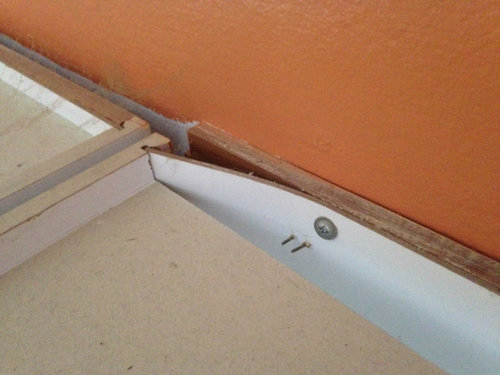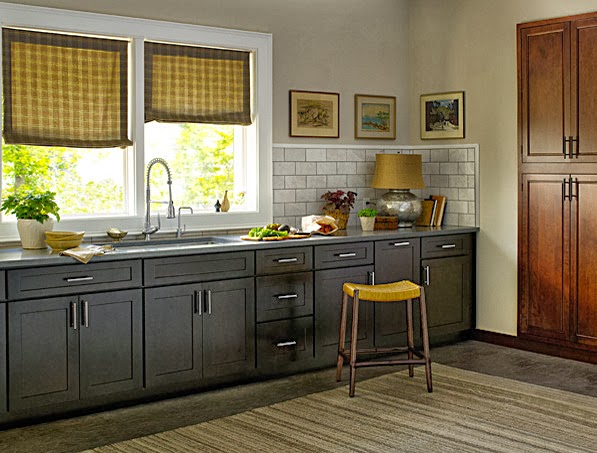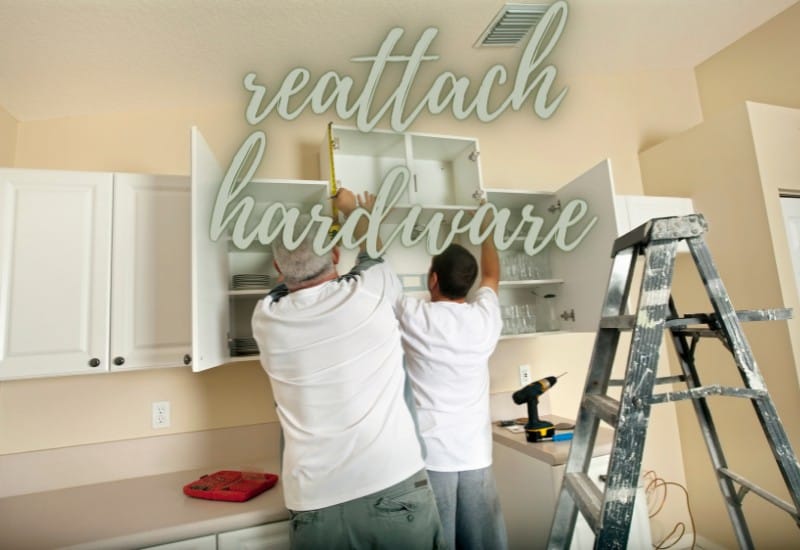How to Fix a Separating Lower Kitchen Cabinet from the Wall
If you've noticed that your lower kitchen cabinet is starting to pull away from the wall, it's important to take action before it becomes a bigger problem. Not only can a separating cabinet be unsightly, but it can also compromise the structural integrity of your entire kitchen. But don't worry, fixing this issue is easier than you might think. Here's how to fix a separating lower kitchen cabinet from the wall.
5 Common Kitchen Cabinet Problems and Solutions
Lower kitchen cabinets can experience a variety of issues, from sagging shelves to loose doors. But one of the most common problems is when the cabinet starts to separate from the wall. This can happen due to a combination of factors, including poor installation, age, and weight of the cabinet. Fortunately, there are solutions to this problem that can save you time and money. Let's take a look at some of the most common kitchen cabinet problems and how to fix them.
How to Repair a Loose Kitchen Cabinet
If your lower kitchen cabinet is just starting to pull away from the wall, you may be able to repair it without having to replace the entire cabinet. The first step is to determine where the issue is coming from. Is it the cabinet itself, the wall, or the screws holding the cabinet in place? Once you have identified the problem, you can use wood glue, screws, and brackets to reinforce the cabinet and secure it back to the wall.
DIY Kitchen Cabinet Repair: Tips and Tricks
Fixing a separating lower kitchen cabinet doesn't have to be a daunting task. With a few tools and some basic DIY skills, you can save yourself the cost of hiring a professional and successfully repair the cabinet yourself. Some tips and tricks to keep in mind include using a level to ensure the cabinet is straight, using wood shims to fill any gaps, and using a drill to attach the cabinet securely to the wall. Remember to always follow safety measures and take your time to avoid any injuries or mistakes.
How to Secure a Loose Kitchen Cabinet
If your lower kitchen cabinet is constantly pulling away from the wall, even after you've attempted to repair it, you may need to take additional measures to secure it. One solution is to install brackets on the inside of the cabinet to reinforce the connection between the cabinet and the wall. You can also try adding additional screws to further secure the cabinet. If the wall itself is the issue, you may need to add additional support, such as a wooden block, behind the wall to provide a stronger base for the cabinet.
Fixing a Sagging Kitchen Cabinet
In some cases, a lower kitchen cabinet may start to sag as it separates from the wall. This can happen due to the weight of the cabinet and its contents, as well as poor installation. To fix this issue, you can use a jack or a block of wood to lift the cabinet back into place, then reinforce it with brackets or additional screws. It's important to address this issue as soon as possible, as a sagging cabinet can eventually lead to a complete separation from the wall.
How to Reattach a Kitchen Cabinet to the Wall
If your lower kitchen cabinet has completely separated from the wall, you will need to reattach it using the same process as if it were a new installation. This involves measuring and marking where the cabinet will be placed, drilling holes for screws, and using a level to ensure it is straight. Make sure to use strong screws and brackets to secure the cabinet to the wall. You may also want to reinforce the bottom of the cabinet with a wooden block for added support.
Common Kitchen Cabinet Repair Mistakes to Avoid
Repairing a separating lower kitchen cabinet may seem like a simple task, but there are some common mistakes that can lead to bigger problems. These include not using a level to ensure the cabinet is straight, using weak or incorrect screws, and not reinforcing the cabinet with brackets or additional support. It's important to take your time and follow proper techniques to ensure a successful repair that will last for years to come.
How to Prevent Kitchen Cabinets from Separating from the Wall
To avoid the hassle of having to repair a separating lower kitchen cabinet, it's important to take preventive measures. This includes using strong and sturdy materials during installation, ensuring the cabinet is properly anchored to the wall, and regularly checking for any signs of wear or damage. You can also distribute the weight of your cabinet's contents evenly to prevent excessive strain on the cabinet and wall.
When to Call a Professional for Kitchen Cabinet Repair
If you're not comfortable with DIY repairs or if the issue with your lower kitchen cabinet is beyond your expertise, it's best to call a professional for help. They will have the experience and tools necessary to properly assess and fix the problem, saving you time and potential headaches. Don't hesitate to reach out to a professional if you feel the issue is too complex or if you're unsure of how to proceed.
In conclusion, a separating lower kitchen cabinet from the wall may seem like a major problem, but with the right tools and techniques, it can be easily fixed. By following these tips and tricks, you can save yourself time and money and ensure that your kitchen remains functional and aesthetically pleasing. Remember to always take preventive measures and address any issues as soon as they arise to avoid any further damage or complications.
Proper Installation and Maintenance Can Prevent Lower Kitchen Cabinet Separation
Understanding the Common Issue of Lower Kitchen Cabinet Separation
 Lower kitchen cabinet separation is a common issue that many homeowners face. This occurs when the cabinets start to pull away from the wall, causing gaps and unevenness. While this may seem like a minor problem, it can actually cause major issues if not addressed properly. Not only does it affect the aesthetic of your kitchen, but it can also compromise the structural integrity of your cabinets and potentially lead to further damage. Understanding the causes and solutions for this problem can help you prevent and address it in your own kitchen.
Lower kitchen cabinet separation is a common issue that many homeowners face. This occurs when the cabinets start to pull away from the wall, causing gaps and unevenness. While this may seem like a minor problem, it can actually cause major issues if not addressed properly. Not only does it affect the aesthetic of your kitchen, but it can also compromise the structural integrity of your cabinets and potentially lead to further damage. Understanding the causes and solutions for this problem can help you prevent and address it in your own kitchen.
The Main Cause of Lower Kitchen Cabinet Separation
 The main cause of lower kitchen cabinet separation is poor installation. When cabinets are not properly secured to the wall, they can easily become loose and start to pull away. This can be due to a variety of reasons such as using the wrong size or type of screws, not using enough screws, or not properly anchoring the cabinets to studs in the wall. It is important to hire a professional or follow manufacturer's instructions carefully when installing kitchen cabinets to avoid this issue.
The main cause of lower kitchen cabinet separation is poor installation. When cabinets are not properly secured to the wall, they can easily become loose and start to pull away. This can be due to a variety of reasons such as using the wrong size or type of screws, not using enough screws, or not properly anchoring the cabinets to studs in the wall. It is important to hire a professional or follow manufacturer's instructions carefully when installing kitchen cabinets to avoid this issue.
The Importance of Regular Maintenance
 In addition to proper installation, regular maintenance is crucial in preventing lower kitchen cabinet separation. Over time, cabinets can become loose and shift due to daily use and wear and tear. It is important to regularly check and tighten any loose screws or brackets to ensure that your cabinets remain securely attached to the wall. This simple step can save you from potential larger issues in the future.
In addition to proper installation, regular maintenance is crucial in preventing lower kitchen cabinet separation. Over time, cabinets can become loose and shift due to daily use and wear and tear. It is important to regularly check and tighten any loose screws or brackets to ensure that your cabinets remain securely attached to the wall. This simple step can save you from potential larger issues in the future.
Additional Tips to Prevent Lower Kitchen Cabinet Separation
 Aside from proper installation and maintenance, there are a few other tips that can help prevent lower kitchen cabinet separation. Using high-quality and sturdy materials for your cabinets can make a big difference in their durability and stability. Additionally, avoiding excessive weight on your cabinets, such as overloading them with heavy dishes or appliances, can also prevent them from pulling away from the wall.
Aside from proper installation and maintenance, there are a few other tips that can help prevent lower kitchen cabinet separation. Using high-quality and sturdy materials for your cabinets can make a big difference in their durability and stability. Additionally, avoiding excessive weight on your cabinets, such as overloading them with heavy dishes or appliances, can also prevent them from pulling away from the wall.
Conclusion
 Taking the necessary precautions during installation and regularly maintaining your kitchen cabinets can go a long way in preventing lower kitchen cabinet separation. By understanding the main causes and implementing these tips, you can ensure that your kitchen cabinets remain secure and in good condition for years to come. If you do notice any signs of separation, it is important to address the issue as soon as possible to avoid further damage. With proper care and attention, your kitchen cabinets can not only enhance the design of your kitchen, but also provide long-lasting functionality.
Taking the necessary precautions during installation and regularly maintaining your kitchen cabinets can go a long way in preventing lower kitchen cabinet separation. By understanding the main causes and implementing these tips, you can ensure that your kitchen cabinets remain secure and in good condition for years to come. If you do notice any signs of separation, it is important to address the issue as soon as possible to avoid further damage. With proper care and attention, your kitchen cabinets can not only enhance the design of your kitchen, but also provide long-lasting functionality.





















:max_bytes(150000):strip_icc()/guide-to-common-kitchen-cabinet-sizes-1822029-base-6d525c9a7eac49728640e040d1f90fd1.png)



























































































